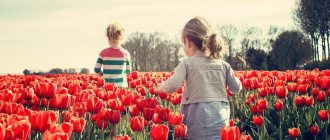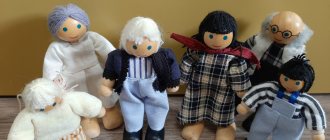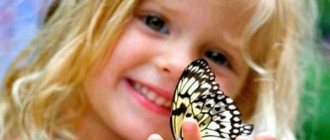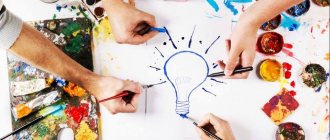Means and methods of aesthetic education in the system of preschool educational organization
Korneva Tatyana Aleksandrovna Migaleva Marina Vladimirovna teachers MBDOU DS No. 72 “Watercolor”
The concept of “aesthetic education” is closely related to the term aesthetics. Aesthetics (from the Greek aisthetiris - sentient, related to sensory perception) is the science of the most general laws of aesthetic, including artistic, human mastery of reality. [4, p.105].
According to scientists, nature is a powerful means of aesthetic education. It is in nature that one can see harmony - the basis of beauty: a variety of colors, shapes, sounds in their combination. Nature itself is a condition for the comprehensive education and development of a child. It becomes a means when an adult purposefully uses its “educational potential” and makes it visible to the child.
The teacher reveals the natural world to children and helps them see it. You just need to see this beauty for yourself and find words that are accessible to the heart of a child. Works of art about nature will provide him with invaluable help in this, which he must know well and skillfully use. In education using the means of nature, it is necessary not only a passive contemplative, but also an effective principle (to protect nature, to help it).
Social life, the work of people with whom the child constantly encounters, is also an important means of aesthetic education. The well-coordinated work of builders makes children want to create a good building, act together, and be attentive to each other. Descriptions of the work of sailors, pilots, teachers, and doctors not only introduce preschoolers to these professions, but also make them want to imitate them. All this is reflected in their games and contributes to the education of moral and aesthetic feelings. [3, p. 157-162]
A multifaceted and inexhaustible means of aesthetic education is art: fine art, music, literature, architecture, theater, cinema. The early introduction of children to real high art contributes to the emergence in the child’s soul of a truly aesthetic perception of reality. Many scientists note that each type of art reflects life in its own way and has its own special impact on the mind and feelings of a child.
Advertising message
Another, no less important, means of aesthetic education is the artistic activity of preschoolers, both organized by the teacher and independent. Fine art is necessary for a child. It gives him rich visual images.
All of the above-mentioned means of aesthetic education - everyday life, nature, art, activity - are effective both on their own and in conjunction, but oversaturation is just as harmful to development as a lack of emotional impact. We must search and find the golden mean.
Having studied the most effective means of aesthetic education in a preschool educational organization, we will move on to studying the methods of aesthetic education.
A method is a way to achieve a goal, a way to solve problems [3, p. 32-39].
Methods of aesthetic education are very diverse. They depend on many conditions: the volume and quality of artistic information, forms of organization and types of activities, and the age of the child. The level of training, skill and abilities of the teacher play a significant role.
A child receives aesthetic information through many channels (social environment, objective world, natural phenomena, works of art). Based on how children receive aesthetic information, methods of aesthetic education can be divided: visual and verbal. Methods also change depending on the forms of organization of activities. During art classes, the teacher gives precise instructions, shows or invites the children to find performance techniques themselves. In practice, methods are used to develop observation skills, independent actions, planning one’s activities and implementing plans. Depending on the age, level of preparedness, growth of individual needs and aspirations of the children, the methods become more complicated.
It should be noted that there are many components that determine the nature of aesthetic education methods. It is difficult to accurately classify them, since they always exist in close connection with others. [5, p. 13-18]
Pedagogical science and practice determine a number of the most effective methods that contribute to the formation of children’s aesthetic feelings, attitudes, judgments, assessments, and practical actions: – the method of persuasion, aimed at developing aesthetic perception, appreciation, and initial manifestations of taste;
- training method, exercises in practical actions designed to transform the environment and develop skills of a culture of behavior;
- method of problem situations that encourage creative and practical actions;
- a method of inducing empathy, emotionally positive responsiveness to the beautiful, and a negative attitude towards the ugly in the world around us [5, p. 87-92].
The peculiarity of the method of persuasion in relation to aesthetic education is that it can be used only when the perceived phenomenon is beautiful. An emotional response occurs in a child when he comes into direct contact with works of art and when he participates in public celebrations. This method can be considered both a visual and verbal method, since any observation of children is accompanied by a simultaneous or subsequent comment from the teacher, awakening the child’s feelings and thoughts.
Systematic exercises in artistic activities and feasible participation in the practice of transforming the immediate environment deepen the activity of children. The method of training and exercise requires repeated repetition. It is used in various conditions. Changing situations helps the child use the acquired skills and strive for further improvement. Repeated exercises in changing conditions allow you to more successfully achieve the desired results. It is important to know that persuasion and training methods do not exist in isolation. Convincing the child of the importance of good deeds, the teacher repeatedly returns to this, as if accustoming children to them.
Thus, the means and methods of aesthetic education we consider in the article in a preschool educational organization help awaken in children a sense of beauty, a desire to act according to their own, childish, but laws of beauty. At the present stage, these means and methods are effective and contribute to the formation of aesthetic feelings, attitudes, judgments, assessments, and practical actions in children.
In general, only a set of methods and means can provide a complete aesthetic education of a child.
Bibliography:
- Barysheva T.A. Empathy and music perception. Interaction of arts in the pedagogical process. – M.: Infra-M, 2000.
- Bolotina L.R. Preschool pedagogy. Textbook / L.R. Bolotina, T.S. Komarova, S.P. Baranova. – Academic project 2005 – 240 p.
- Vendrova T.E., Pisareva I.V. Education with music. – M.: 1991 – 50 p.
- Gogoberidze A.G. Theory and methods of musical education of preschool children. – M.: Publishing House, 2005. – 320 p.
- Kovalitskaya L.M. Methodology for developing skills in visual arts in preschool educational institutions. – Publisher: Arkti, 2008 – 74 p.
Participation – full-time
Section 1. “Methods and techniques for organizing search and research activities of preschool children”
Formation and development of preschoolers’ aesthetic attitude towards the world around them. article
Formation and development of preschoolers’ aesthetic attitude to the world around them.
From early childhood, a child discovers and explores the world around him, he is drawn to the beautiful, bright, and experiences the joy of communicating with nature. He discovers the world in a variety of colors and sounds. Scientists have proven that it is in preschool age that all the foundations for the entire future development of humanity are laid. Preschool age is the most important stage of personality development and education. This is the period of the child’s familiarization with the knowledge of the world around him, the period of his initial socialization. It is at this age that independent thinking is activated, children’s cognitive interest and curiosity develops. Adults and children constantly encounter aesthetic phenomena. In the environment of spiritual life, everyday work, communication with art and nature, in everyday life, and interpersonal communication - everywhere the beautiful and the ugly, the tragic and comic play a significant role. Beauty brings pleasure and pleasure, stimulates work activity, the ugly repels, and the tragic teaches empathy.
Aesthetic education is the process of purposefully developing in a person the ability to understand and appreciate the beautiful and comic, to feel and experience the tragic, to create beauty in all spheres of life.
This means that in the process of aesthetic education two tasks are solved: the improvement of all components of aesthetic consciousness and the formation of the need and ability to introduce harmony and perfection into the labor process and its results.
Communicating with the aesthetic phenomena of life and art, the child develops, but does not realize the aesthetic essence of objects. Without outside intervention, a child may develop incorrect ideas about life, values and ideals. Communication with adults, the behavior of others, views, gestures, facial expressions - all this is recorded and deposited in his mind.
The child's initial social circle is limited to his parents and immediate relatives. Therefore, their responsibility for shaping the world of aesthetic feelings and ideas of the child is extremely great. The power of childhood impressions and their longevity are well known. Therefore, the foundations of the aesthetic culture of a future personality are laid precisely in the family, in the early stages of development, when the child’s mental development is especially rapid.
The organization of children's everyday life plays a significant role in the aesthetic education of a child: cleanliness, order, convenience, beauty, where everything is proportionate, coordinated in color, shape, size. From the age of 2, children should be involved in creating a world of beauty by putting things in order in the room and keeping their clothes neat. This way the child will develop an understanding that beauty is the work of man. Knowledge of color, shape and size occurs through manipulation of objects, the ability to model and design. Therefore, the presence of varied and colorful toys and objects in the child’s environment is of great importance. The development of a child’s artistic interests, creative imagination and abilities, and the acquisition of practical skills begins at an early age. At this age, the formation of an aesthetic ideal, an idea of the perfect, begins.
A special role in aesthetic education is given to art. Its characteristic feature is the reflection of reality in artistic images, which act on a person’s consciousness and feelings, and instill in him a certain attitude towards the events and phenomena of life. The child begins to develop artistic taste, that is, a developed ability to feel and evaluate perfection and imperfection, unity or opposition of content and form in art and life.
The life experience of a child at various stages of his development is so limited that children do not soon learn to distinguish aesthetic phenomena from the general mass. The teacher’s task is to cultivate in the child the ability to enjoy art, to develop aesthetic needs and interests, and to bring them to the level of aesthetic taste. An important sign of aesthetic education is the developed ability to admire beauty, perfection in art and life. When considering the problem of aesthetic education through art, it is necessary to take into account age characteristics.
The tasks of aesthetic education are related to the formation of the child’s moral character. In order to learn to understand the beauty in art and life, it is necessary to accumulate aesthetic impressions and develop emotional and cognitive processes. Therefore, aesthetic education is not an isolated area of pedagogy, but interacts with all its aspects. Aesthetic education is closely related to other forms of educational activity - intellectual, labor, moral, physical. The result of aesthetic education is aesthetic development.
S.A. Kozlova and T.A. Kulikova distinguish two groups of tasks of aesthetic education:
- formation of children’s aesthetic attitude towards the environment (develop the ability to see and feel beauty in nature, actions, art, understand beauty; cultivate artistic taste, the need for knowledge of beauty);
- formation of artistic skills in the field of various arts (teaching children drawing, modeling, designing, singing, moving to music, developing verbal creativity).
These two areas are closely interconnected. For their implementation, the following conditions are necessary:
- environment (toys, clothing, premises);
- the saturation of everyday life with works of art;
- independent active activity of children;
- implementation of an individual approach to the child.
Artistic and aesthetic education of preschool children through introduction to the world of art
Elena Alexandrina
Artistic and aesthetic education of preschool children through introduction to the world of art
We can look at a beautiful picture, admire a statue, admire the brilliant creation of an architect. But the ultimate goal of communicating with works of art can only be reduced to comprehending their formal structure. However, if we want our aesthetic perception to be more complete , so that we can experience the feelings that excited the artist , we must strive to understand the language of the art in which he worked. The world of art is rich and complex . In order for a person to enter it not as if into a dark unknown forest, full of all sorts of surprises, he must be gradually introduced into this beautiful world from the very first years of life.
One of the means of artistic and aesthetic education of preschoolers is museum pedagogy. The relevance of the development of this direction in pedagogy is due to the fact that the great works that the whole world admires are not always understandable and uninteresting to us; we have forgotten how to “see with our souls”
, see beauty in ordinary surroundings and admire.
We have changed live communication with beauty to virtual. Therefore, as a teacher, I would like to make my contribution to the education of a new , young, understanding museum audience. And the most important thing is that museum pedagogy has a huge impact on the development of the educational potential of preschool .
The work of our preschool institution is aimed at teaching children to celebrate, to see the beautiful in the ordinary, to enrich aesthetic ideas, to teach on the basis of emotional perception to reason , compare and evaluate what they see, to reflect the received artistic and aesthetic ideas in their own artistic and creative activities .
In the artistic and aesthetic education of children through familiarization with the world of arts, the following directions can be distinguished:
— Focus on integration. Ideas about cultural traditions, customs, historical events, examination of the properties and qualities of objects and phenomena, the assimilation of moral norms, rules of behavior and museum culture occur in the process of integration of cognitive, speech, social-personal and artistic-aesthetic education .
-Cultural orientation. Preschoolers images of domestic and world using materials from city museums, city attractions and nature.
-Artistic direction . Organization of ped. The process takes place in a museum environment, based on original works of art .
A lot of work has been done on this topic in our preschool At the initial preparatory stage, teachers objectively assessed their knowledge, the knowledge of students and parents . We analyzed the material and technical base and, based on the results, began practical actions. The preschool educational institution has a “small exhibition hall”
, where reproductions of famous
artists , the exposition changes. A mini museum of national cultures has been created, with exhibits understandable for preschool and made by genuine craftsmen.
In groups, aesthetically valuable exhibits are displayed on beauty shelves. Selections for traveling exhibitions. In our group there is a tradition of children, and teachers discuss in what style, what event the design of the group will correspond to for a certain period of time. Parents take an active part in the design. Children's creativity centers provide an opportunity to develop creative abilities. The kindergarten has a video library “Museums of the World”
and there are technical means for organizing a virtual museum.
In our city there is an exhibition hall in which the works of art school , artists of our city , and artists of Mordovia . We are frequent guests in this wonderful place.
We try to provide pedagogical education for parents and thereby enrich the joint activities of children and adults. The joint activities of children and parents are organized through quizzes, clubs, meetings with interesting people, salons, and the implementation of joint search and educational projects.
We really hope that our children will begin to look at what surrounds us with different eyes, will begin to see beauty or notice unattractiveness in what they previously passed by indifferently.






